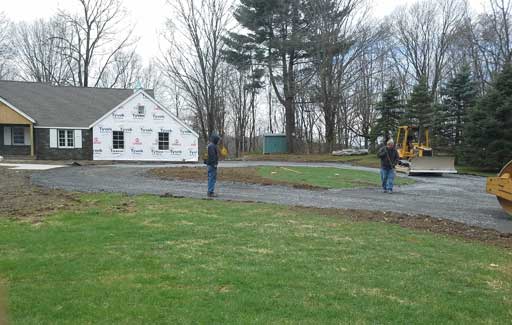With the weather warming up, we all begin to think about outdoor projects. If you are thinking about improving your property’s appearance by paving your driveway, here are some important things to keep in mind.
Working from the ground up, first the raw ground must be graded correctly. It is important to check if any nearby trees have roots running underneath the surface. These roots may need to be removed, otherwise, as they grow and expand, they will compromise your finished drive’s surface causing it to heave and rupture. This step also is the “ground work” for proper drainage by providing sufficient slope for draining water off and away from the driveway. If water is allowed to pond on the drive’s surface or next to the driveway, it potentially can seep underneath to weaken the soli or cause frost heaving.
Next, it is imperative to consider laying a good stone base. Without the proper base, your project is doomed to failure from the start! Choose a contractor with the proper equipment to compact this subbase. Mechanical compaction of the subbase is crucial for a long-lasting driveway.
Finally, I recommend at least a two and a half inch application of pavement to insure longevity. Your contactor should use a 1- to 3- ton roller for compacting the pavement itself. The edges of the surface need to be sloped properly to allow for good drainage. A good job also will include a perfect meeting of the driveway and the street or road. In some cases depending on your location and how much potential ground water is present, a drainage swale or pipe may be needed to keep that portion of your driveway from eroding.
When you are choosing a company, remember all of these important points. A low bid may signal that a contractor isn’t planning to install a good base, or they plan to use a thinner layer of pavement. Sometimes it is true, “You get what you pay for!”
Be sure to ask your contractor for all the details before signing a contract. I recommend your using a local contractor, like me or another local paving company that stand behind their workmanship 100%; and who will be there for you in the future should any problems occur.
Now that your driveway has been installed or resurfaced and has had time to cure, I recommend sealing it. The sealant is a substance that sits on top of the driveway and provides a barrier preventing water, ice, sun and car fluids from marring and/or eating away at the driveway’s surface.
In our Northeastern Pennsylvania climate with cold, harsh winters and numerous freeze-thaw cycles, I recommend sealing a new driveway for at least the first two years. Thereafter, sealing either every one or two years should be adequate depending on the “look” you prefer which is a matter of personal preference. Some homeowners prefer a shiny, smooth blackened appearance, while others favor the more traditional look of flat black macadam. And, of course, if over the winter snow removal is done by a plow, the plow’s blade may leave unsightly scratches and scrapes on the drive’s surface which you may wish to eliminate by sealing each and every year.
No matter when or why you reseal, be certain that your sealer contains some sort of “grit” which will provide traction and help prevent a future “slip-and-fall” on a wet driveway surface.
Hope this has been helpful.

